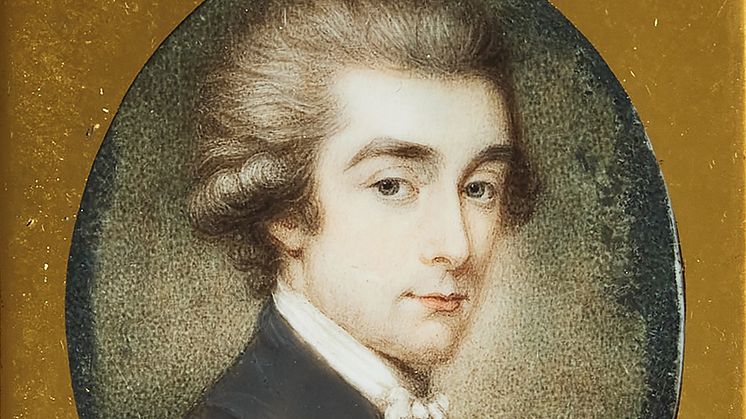
Press release -
Nationalmuseum acquires iconic portrait of Axel von Fersen
Nationalmuseum has acquired a portrait of Axel von Fersen at the age of 23, painted in London in the summer of 1778. The superb miniature by an unknown British artist depicts a self-assured young man, perhaps on account of his intended marriage to a rich heiress. It was unusual for British artists to paint portraits of Swedish subjects in the latter half of the 18th century.
Axel von Fersen (1755–1810) has become known around the world for his close relationship with Queen Marie-Antoinette. As the current exhibition at the Archives Nationales in Paris makes clear, his affections were reciprocated. They first met at a masked ball in January 1774. Some months later, Fersen travelled to London. Although he did not stay long, he learned some English, which was unusual for a Swede in the 18th century. Fersen returned to the British capital in April 1778 for a visit lasting four months, during which time he sat for an unidentified portrait painter. The graphic nature of the portrait, where the hair and face are made up of a combination of lines and dots in brown tones against a gridlike background, is typical of British miniature painting of the time. In contrast to this vibrant depiction, the subject’s grey coat appears somewhat muted, with a few shaded areas.
Why did the young Fersen commission this portrait of himself during his time in London? Did it have something to do with his intended marriage to Catharina, the daughter of Henrik Leijel (Henry Lyell), a wealthy Swedish-British merchant? Nothing came of this prospective marriage of convenience. Instead, Fersen returned to Paris and embarked on a military career. Two years later, he travelled to North America as aide-de-camp to the head of the French expeditionary force, General Count de Rochambeau. Fersen’s knowledge of English proved very useful in this role, since General George Washington did not speak French. For three years, Fersen acted as interpreter between the allies in their war against the British colonial power. On returning to Paris in the summer of 1783, he was appointed colonel of the Royal Suédois regiment, but soon after was ordered to accompany King Gustav III of Sweden on a year-long trip to Italy.
The rest of the story is well known: Fersen’s love affair with Marie-Antoinette, his repeated attempts to save her and other members of the royal family during the French Revolution, and his own tragic death at the hands of a mob on the streets of Stockholm. The portrait of the young Fersen eventually came into the possession of one of his siblings and remained in the family’s ownership for many years before its recent acquisition by Nationalmuseum.
Magnus Olausson, emeritus director of collections at Nationalmuseum, said:
“The portrait of the young Axel von Fersen represents a rare interlude in 18th-century Swedish-British relations. As far as we know, few Swedes were immortalised by British artists in those days.
This iconic portrait of Fersen is an unusually fine work by an unknown British miniaturist, in a style somewhat reminiscent of stipple engraving, which was the great innovation of the time.”
Nationalmuseum receives no state funds with which to acquire design, applied art and artwork; instead the collections are enriched through donations and gifts from private foundations and trusts. The Axel von Fersen portrait acquisition was generously funded by the Hjalmar and Anna Wicander Foundation.
Inventory number
Unknown British artist, Portrait of Axel von Fersen, 1778. NMB 2828.
Media contacts
Magnus Olausson, emeritus director of collections, magnus.olausson@nationalmuseum.se, +46 8 5195 4371
Hanna Tottmar, head of press, press@nationalmuseum.se, +46 8 5195 4400
Categories
Nationalmuseum is Sweden’s museum of art and design. The collections comprise some 700 000 objects, including paintings, sculpture, drawings and graphic art from the 16th century up to the beginning of the 20th century and the collection of applied art and design up to the present day. Nationalmuseum is a government authority with a mandate to preserve cultural heritage and promote art, interest in art and knowledge of art.

